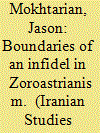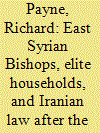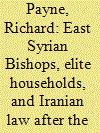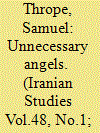|
|
|
Sort Order |
|
|
|
Items / Page
|
|
|
|
|
|
|
| Srl | Item |
| 1 |
ID:
137182


|
|
|
|
|
| Summary/Abstract |
This paper explores the Middle Persian term agdēn, which is often problematically translated as “infidel.” By tracing this term of otherness through Middle Persian texts such as legal cases in The Book of a Thousand Judgments and polemics in the Dēnkard Book III, this article argues that the concept of the infidel frequently appears in discussions about slavery, intermarriage, and conversion to and from Zoroastrianism. Middle Persian legal and theological texts regarding infidels deal with cases in which Zoroastrian interactions with non-Zoroastrians impinge upon Zoroastrian boundaries of identity. Moreover, the term agdēn often refers to Jews, Christians, and Muslims, thereby offering insight into the ties between Zoroastrian self-identity and other groups which the Persian priests encountered. In the end, this paper demonstrates the need for further intensive studies into Middle Persian technical terms of otherness as they lie at the heart of questions of Zoroastrian self-definition and attitudes towards others.
|
|
|
|
|
|
|
|
|
|
|
|
|
|
|
|
| 2 |
ID:
137177


|
|
|
|
|
| Summary/Abstract |
This article is an exploration of the interconnected legal ties between Christians and Zoroastrians in the early Islamic era. Drawing from the writings of the Christian authors Ishobokt, Simeon, and Henanisho, Payne describes how East Syrian bishops appropriated laws of marriage, inheritance, and property from Iranian jurisprudential traditions as a means of transferring wealth intergenerationally and extending their judicial authority. Payne thus explores the ways in which the Christians of Iran were influenced by the Iranian legal system and culture and in the seventh century CE.
|
|
|
|
|
|
|
|
|
|
|
|
|
|
|
|
| 3 |
ID:
137178


|
|
|
|
|
| Summary/Abstract |
This article is an exploration of the interconnected legal ties between Christians and Zoroastrians in the early Islamic era. Drawing from the writings of the Christian authors Ishobokt, Simeon, and Henanisho, Payne describes how East Syrian bishops appropriated laws of marriage, inheritance, and property from Iranian jurisprudential traditions as a means of transferring wealth intergenerationally and extending their judicial authority. Payne thus explores the ways in which the Christians of Iran were influenced by the Iranian legal system and culture and in the seventh century CE.
|
|
|
|
|
|
|
|
|
|
|
|
|
|
|
|
| 4 |
ID:
137180


|
|
|
|
|
| Summary/Abstract |
This paper argues that the designation of heterodoxy for the socio-religious movements of late antique Iran such as Mazdakism is a misnomer. It suggests that the designation of Mazdakism and similar movements as heterodoxies is in fact the product of an early Islamic assessment of post-Sasanian Zoroastrian attempts to create a Zoroastrian orthodoxy which did not exist under Sasanian rule. Pressured by the Abrahamic religions surrounding them, the followers of Weh Dēn in this period felt the need to demarcate and clarify their beliefs, and to make their own beliefs comprehensible to their neighbors and rulers. What was then left out of this attempt was labeled a deviation, and heterodoxy, whose fundamental disagreement with Zoroastrian orthodoxy was then reflected back in time.
|
|
|
|
|
|
|
|
|
|
|
|
|
|
|
|
| 5 |
ID:
137181


|
|
|
|
|
| Summary/Abstract |
This article proposes a new approach to three of the most persistent problems in the study of Iranian art and religion from the coming of Alexander to the fall of the Sasanians: the development of Iranian sacred architecture, the legacy of the Achaemenids, and the development of the art and ritual of Iranian kingship after Alexander. Canepa explores the ways in which the Seleukids contributed basic and enduring elements of Iranian religious and royal culture that lasted throughout late antiquity. Beyond stressing simple continuities or breaks with the Babylonian, Achaemenid or Macedonian traditions, this article argues that the Seleukids selectively integrated a variety of cultural, architectural and religious traditions to forge what became the architectural vocabularies and religious expressions of the Middle Iranian era.
|
|
|
|
|
|
|
|
|
|
|
|
|
|
|
|
| 6 |
ID:
137179


|
|
|
|
|
| Summary/Abstract |
The Škand Gumānīg Wizār (ŠGW) contains Middle Persian Zoroastrian literature's most extensive polemic against Judaism. This article explores the ŠGW's polemic in light of recent scholarship demonstrating the connection between Babylonian rabbinic Judaism and Zoroastrianism in late antique Iran. Taking this connection as a starting point, the article considers the ŠGW's critique of three angelic citations that are all closely paralleled by passages in the Babylonian Talmud. After demonstrating that the ŠGW citations depict angels as weaker and more oppressed than the rabbinic parallels, the article sets these portrayals of weakened angels in the context of the widespread belief among Jews in this period in Metatron, an angelic coequal to the divine. The article argues that the ŠGW's depictions of downtrodden angels are not borrowed from rabbinic polemics, found in the Talmud, against this theology, but is an independent reaction to the same belief in Metatron's co-regency, a belief that sources testify was still common in the early Islamic period. The ŠGW's motivating theological imperative to portray Judaism as radically monotheistic, and thus the binary opposite of Zoroastrianism, underlies the text's descriptions of angelic suffering and degradation.
|
|
|
|
|
|
|
|
|
|
|
|
|
|
|
|
|
|
|
|
|